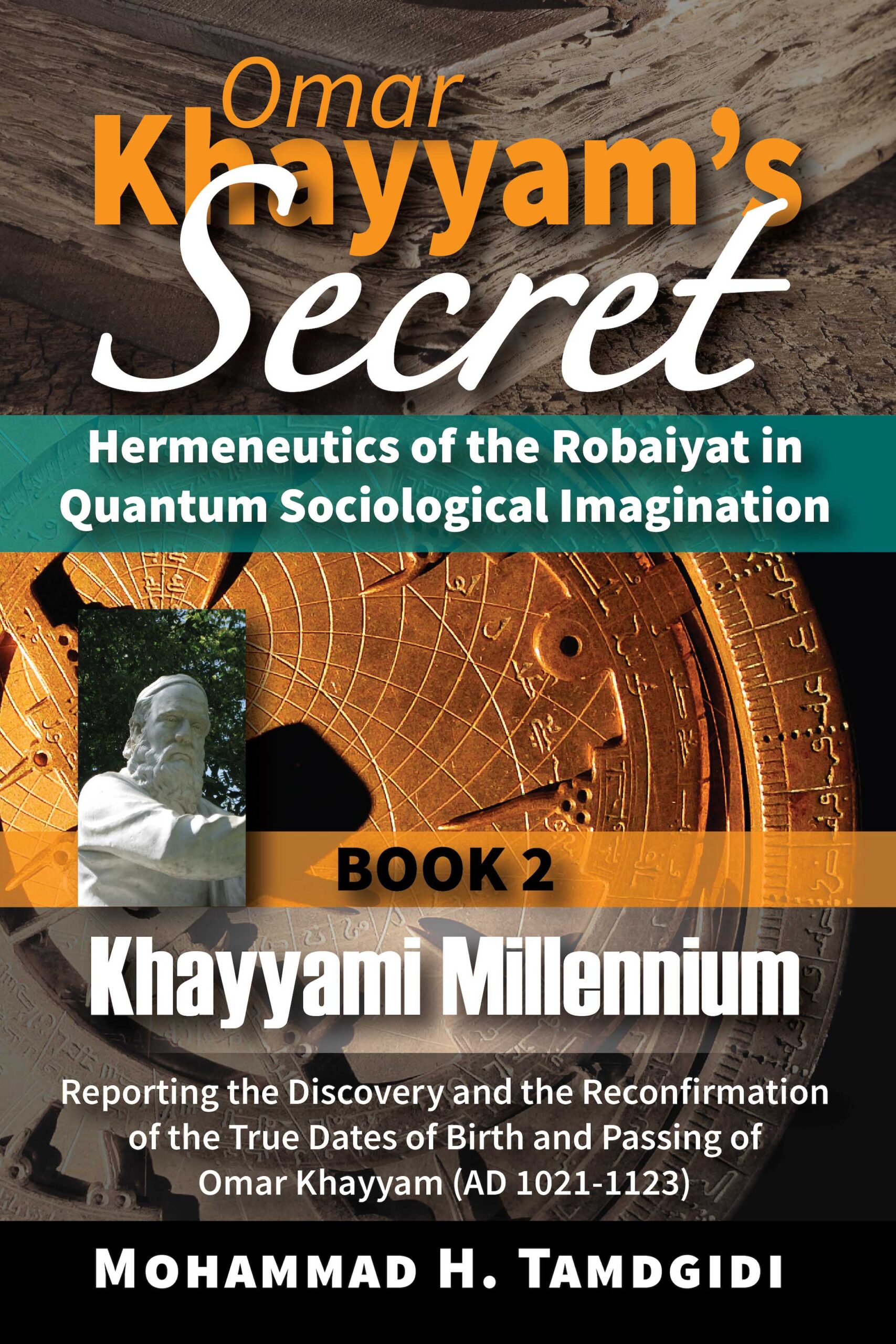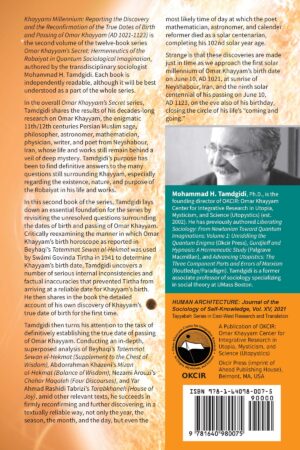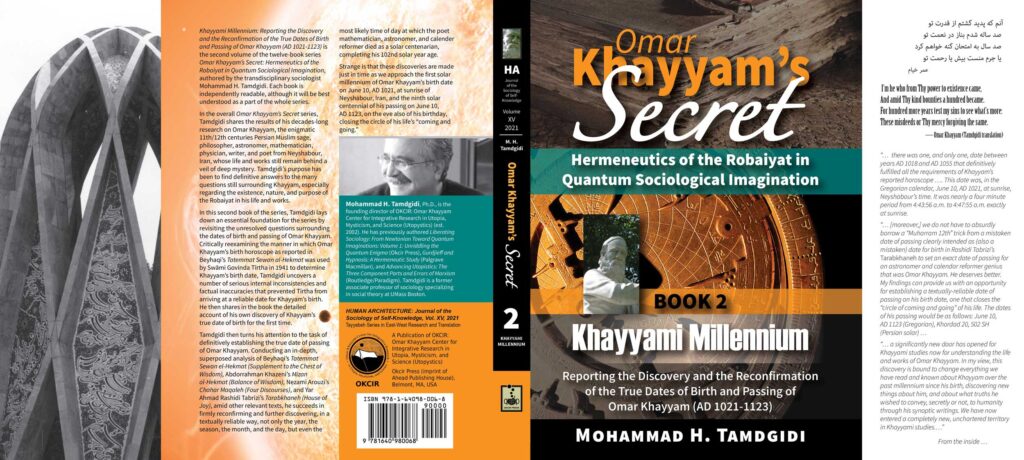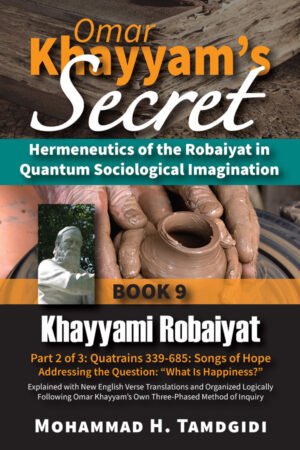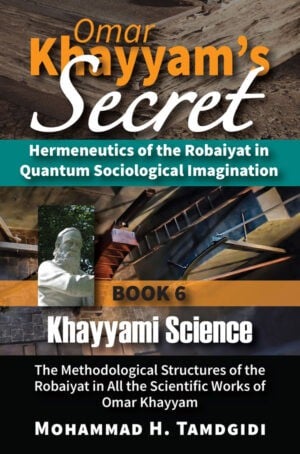Omar Khayyam’s Secret: Hermeneutics of the Robaiyat in Quantum Sociological Imagination: Book 2: Khayyami Millennium: Reporting the Discovery and the Reconfirmation of the True Dates of Birth and Passing of Omar Khayyam (AD 1021-1123)
$69.99 – $99.00
In this book of his Omar Khayyam’s Secret series, Mohammad H. Tamdgidi reports having discovered and reconfirmed Omar Khayyam’s true dates of birth and passing (AD 1021-1123), shortly before his birth millennium on June 10, 2021.
Publication Date: June 1, 2021
Note: The ePub ebook edition of this title (ISBN: 9781640980082) can be purchased from major online ebook stores worldwide.

All the sections of this publication can be read online by logged-in members of the OKCIR Library with a valid access. In that case click on any section in the table of contents below, and then click on the large PDF icon at the bottom of that page to access the publication section. Alternatively, you can purchase this publication as offered below.
Description
Omar Khayyam’s Secret: Hermeneutics of the Robaiyat in Quantum Sociological Imagination
Book 2: Khayyami Millennium
Reporting the Discovery and the Reconfirmation of the True Dates of Birth and Passing of Omar Khayyam (AD 1021-1123)
Author: Mohammad H. Tamdgidi
Publication Date: June 1, 2021
Human Architecture: Journal of the Sociology of Self-Knowledge (ISSN: 1540-5699)
Volume XV, 2021, Monograph Series: Tayyebeh Series in East-West Research and Translation
Description
Omar Khayyam’s Secret: Hermeneutics of the Robaiyat in Quantum Sociological Imagination is a twelve-book series of which this book is the second volume, subtitled Khayyami Millennium: Reporting the Discovery and the Reconfirmation of the True Dates of Birth and Passing of Omar Khayyam (AD 1021-1123). Each book is independently readable, although it will be best understood as a part of the whole series.
In the overall series, the transdisciplinary sociologist Mohammad H. Tamdgidi shares the results of his decades-long research on Omar Khayyam, the enigmatic 11th/12th centuries Persian Muslim sage, philosopher, astronomer, mathematician, physician, writer, and poet from Neyshabour, Iran, whose life and works still remain behind a veil of deep mystery. Tamdgidi’s purpose has been to find definitive answers to the many puzzles still surrounding Khayyam, especially regarding the existence, nature, and purpose of the Robaiyat in his life and works. To explore the questions posed, he advances a new hermeneutic method of textual analysis, informed by what he calls the quantum sociological imagination, to gather and study all the attributed philosophical, religious, scientific, and literary writings of Khayyam.
In this second book of the series, Tamdgidi lays down an essential foundation for the series by revisiting the unresolved questions surrounding the dates of birth and passing of Omar Khayyam. Critically reexamining the manner in which Omar Khayyam’s birth horoscope as reported in Zahireddin Abolhassan Beyhaqi’s Tatemmat Sewan al-Hekmat (Supplement to the Chest of Wisdom) was used by Swāmi Govinda Tīrtha in his The Nectar of Grace: Omar Khayyam’s Life and Works (1941) to determine Khayyam’s birth date, Tamdgidi uncovers a number of serious internal inconsistencies and factual inaccuracies that prevented Tīrtha (and, since then, other scholars more or less taking for granted his results) from arriving at a reliable date for Khayyam’s birth, hurling Khayyami studies into decades of confusion regarding Khayyam’s life and works. Tamdgidi then shares in the book the detailed account of his own discovery of Khayyam’s true date of birth for the first time, a finding that eluded Khayyami studies for centuries and is bound to revolutionize the studies for decades to come.
Tamdgidi then turns his attention to the task of definitively establishing the true date of passing of Omar Khayyam. Conducting an in-depth, superposed analysis of Beyhaqi’s Tatemmat Sewan el-Hekmat (Supplement to the Chest of Wisdom), Abdorrahman Khazeni’s Mizan ol-Hekmat (Balance of Wisdom), Nezami Arouzi’s Chahar Maqaleh (Four Discourses), and Yar Ahmad Rashidi Tabrizi’s Tarabkhaneh (House of Joy), amid other relevant texts, he succeeds in firmly reconfirming and further discovering, in a textually reliable way, not only the year, the season, the month, and the day, but even the most likely time of day at which the poet mathematician, astronomer, and calendar reformer died as a solar centenarian, completing his 102nd solar year age.
Strange is that these discoveries are made just in time as we approach the first solar millennium of Omar Khayyam’s birth date on June 10, 1021, at sunrise of Neyshabour, Iran, and the ninth solar centennial of his passing on June 10, 1123, on the eve also of his birthday, closing the circle of his life’s “coming and going.”
About the Author
Mohammad H. Tamdgidi, Ph.D., is the founding director and editor of OKCIR: Omar Khayyam Center for Integrative Research in Utopia, Mysticism, and Science (Utopystics) and its journal, Human Architecture: Journal of the Sociology of Self-Knowledge (ISSN: 1540-5699), which have served since 2002 to frame his independent research, pedagogical, and publishing initiatives. He is a former associate professor of sociology specializing in social theory at UMass Boston and has taught sociology at SUNY-Binghamton and SUNY-Oneonta.
Besides his currently in progress work published in the book series Omar Khayyam’s Secret: Hermeneutics of the Robaiyat in Quantum Sociological Imagination (Okcir Press), Tamdgidi has previously authored Liberating Sociology: From Newtonian Toward Quantum Imaginations: Volume 1: Unriddling the Quantum Enigma (2020, Okcir Press), Gurdjieff and Hypnosis: A Hermeneutic Study (2009, Palgrave Macmillan), and Advancing Utopistics: The Three Component Parts and Errors of Marxism (2007, Routledge/Paradigm). He has published numerous peer reviewed articles and chapters and edited more than thirty journal issues.
Tamdgidi holds a Ph.D. and M.A. in sociology in conjunction with a graduate certificate in Middle Eastern studies from Binghamton University (SUNY). He received his B.A. in architecture from U.C. Berkeley, following enrollment as an undergraduate student of civil engineering in the Technical College of the University of Tehran, Iran.
His areas of scholarly and practical interest are the sociology of self-knowledge, human architecture, and utopystics-three fields of inquiry he invented in his doctoral studies and has since pursued as respectively intertwined theoretical, methodological and applied fields of inquiry altogether contributing to what he calls the quantum sociological imagination. His research, teaching, and publications have been framed by an interest in understanding how world-historical social structures and personal selves constitute one another. This line of inquiry has itself been a result of his longstanding interest in understanding the underlying causes of failures of the world’s utopian, mystical, and scientific movements in bringing about a just global society.
It was during his undergraduate studies at U.C. Berkeley and in the course of his mentorship by the painter and design architect Jesse Reichek (1916-2005) that Tamdgidi’s notion and project “human architecture” was born. During his graduate studies at SUNY-Binghamton, he was mentored in methods, theory, and world-systems studies by Terence K. Hopkins (1928-1997) and Immanuel Wallerstein (1930-2019), and further in dialectics by Dale Tomich and on space and society by Anthony D. King, amid a uniquely autonomous and flexible transdisciplinary Graduate Program in Sociology founded by T. K. Hopkins.
Omar Khayyam’s Secret: Hermeneutics of the Robaiyat in Quantum Sociological Imagination: Book 2: Khayyami Millennium: Reporting the Discovery and the Reconfirmation of the True Dates of Birth and Passing of Omar Khayyam (AD 1021-1123)
Published by: Okcir Press (an imprint of Ahead Publishing House) • Belmont, Massachusetts • First Edition: June 1, 2021
332 pages • 6×9 inches • Includes references, illustrations, bibliography, and index
Library of Congress Control Number (LCCN): 2021906827
ISBN: 9781640980068 (hard cover with dust jacket: alk. paper)
ISBN: 9781640980075 (soft cover: alk. paper)
ISBN: 9781640980082 (ePub ebook)
ISBN: 9781640980099 (PDF ebook)
CITATION: Tamdgidi, Mohammad H. 2021. Omar Khayyam’s Secret: Hermeneutics of the Robaiyat in Quantum Sociological Imagination: Book 2: Khayyami Millennium: Reporting the Discovery and the Reconfirmation of the True Dates of Birth and Passing of Omar Khayyam (AD 1021-1123). (Human Architecture: Journal of the Sociology of Self-Knowledge: Vol. XV, 2021. Tayyebeh Series in East-West Research and Translation.) Belmont, MA: Okcir Press.
Where to Purchase this Book: The various editions of this volume can be ordered from the Okcir Store and all major online bookstores worldwide (such as Amazon, Barnes&Noble, Google Play, and others).
Table of Contents
Omar Khayyam’s Secret: Hermeneutics of the Robaiyat in Quantum Sociological Imagination: Book 2: Khayyami Millennium: Reporting the Discovery and the Reconfirmation of the True Dates of Birth and Passing of Omar Khayyam (AD 1021-1123)
About the Author—viii
Acknowledgments—xxi
Introduction to Book 2: The Dilemma and Significance of Omar Khayyam’s Dates of Birth and Passing—11
1. Tīrtha’s Solutions to the Problems of Determining Omar Khayyam’s Dates of Birth and Passing—27
2. The Internal Inconsistencies and Factual Inaccuracies of Tīrtha’s Findings—43
1. Chapter Introduction—63
2. Why Did Tīrtha Read the Gemini Degree As ‘3’ Not ‘8’?—65
3. Do Either Degrees 3 Or 8 of Gemini Solve the Puzzle on Any Date During the Period?—69
4. How Have Other Copies Rendered the Gemini Degree?—79
5. Does An Older Copy Necessarily Mean It Is More Authentic?—81
6. A Survey of Various Manuscript Copy Renderings of the Gemini Degree in Khayyam’s Birth Horoscope—83
7. If Neither 3 Nor 8 for the Gemini Degree Solves the Puzzle, What Degree Does?—89
8. Can the Gemini Degree 18 Shed Light on What the Extant Manuscript Copies of Beyhaqi’s Reported Horoscope for Khayyam Were Trying to Tell Us?—105
9. The First Way to Account for the Various Extant Manuscript Copies With One Another—111
10. The Second Way to Account for the Various Extant Manuscript Copies With One Another—113
11. The Third Way to Account for the Various Extant Manuscript Copies With One Another—115
12. The Fourth Way to Account for the Various Extant Manuscript Copies With One Another—117
13. The Fifth Way to Account for the Various Extant Manuscript Copies With One Another—120
14. The Sixth Way to Account for the Various Extant Manuscript Copies With One Another—120
15. The Use of Kufi Script in Arabic Astrolabes for Rendering Abjad Numbers—121
16. How and Where Russian Scholars and Astronomers Went Wrong In Evaluating and Confirming Swāmi Govinda Tīrtha’s Mistaken Date of Birth for Omar Khayyam—123
17. Chapter Conclusion: Omar Khayyam’s True Date of Birth Discovered Shortly Before Its Millennium—127
1. The Most Relevant Manuscripts to Be Studied for the Determination of Khayyam’s Date of Passing—137
2. Could Omar Khayyam Have Been Childhood Friends with Nezam ol-Molk and Hasan Sabbah?—139
3. Examining Beyhaqi’s Biographical Entry on Omar Khayyam in “Tatemmat Sewan el-Hekmat”—141
4. Examining Other Entries by Beyhaqi in “Tatemmat Sewan el-Hekmat” Where Khayyam Is Mentioned —147
5. What Can We Learn from Khazeni’s Manuscript “Mizan ol-Hekmat” About Khayyam’s Date of Passing?—165
1. The Three References to Omar Khayyam in Nezami Arouzi’s “Chahar Maqaleh”—172
2. Examining the Three References to Omar Khayyam in the Prevalent Manuscript Copy of Nezami Arouzi’s “Chahar Maqaleh”—177
3. The Problem of Gross Historiographical Inaccuracies In Nezami Arouzi’s “Chahar Maqaleh” As Unanimously Acknowledged By Scholars—182
4. What Explains the Differences Between the Prevalent and Older Manuscript Copies of Arouzi’s “Chahar Maqaleh”?—187
5. An Important Discovery Just Made Regarding Khayyam’s Authorship of Robaiyat As Reported By His Living Contemporary Nezami Arouzi—195
1. Turning to Yar Ahmad Rashidi Tabrizi’s “Tarabkhaneh” While Not Entirely Leaving Nezami Arouzi’s “Chahar Maqaleh”: Considering the Commentaries By Golpinarli and Homai—202
2. Superposing With the Manuscript Copy of Yar Ahmad Rashidi Tabrizi’s “Tarabkhaneh” Shared by Swāmi Govinda Tīrtha in His “The Nectar of Grace”—215
3. Why the Year Given in “Tarabkhaneh” for Khayyam Is Intended to Be, And Can Only Be, For 444 LH—221
4. Solving the Puzzle of Omar Khayyam’s Year, Season, and Month of Passing By Way of Superposing All the Accounts: The Difference the Apricot and Pear Blossoms Make—231
5. Narrowing the Passing Date Further to Its Day: The Odd Intentionalities Implied in Reliable Accounts About Khayyam’s Own Intended Efforts in Determining the Place and Time of His Passing—247
6. The Two-Year Celebration Window: From the Millennium of Omar Khayyam’s Birth on June 10, 2021 to the Ninth Centennial of His Passing on June 10, 2023—251
Book 2 Index—291
List of Figures
Figure I.1: Tīrtha’s Scan of the First Two Pages of Beyhaqi’s Biography of Omar Khayyam—30
Figure I.2: A Clearer Scan of the First Page of Beyhaqi’s Biography of Omar Khayyam—31
Figure I.3: Horoscope Chart for May 18, AD 1048, 4:48:00 a.m., Gregorian Calendar (May 12, AD 1048 Julian Calendar), Neyshabour, Iran—46
Figure I.4: Horoscope Chart for May 24, AD 1048, 4:48:00 a.m., Gregorian Calendar (May 18, 1048 Julian Calendar), Neyshabour, Iran—47
Figure I.5: Swāmī Govinda Tīrtha’s Listing of Planetary Locations Used to Offer His Astrological Reading (on page XXXVII) of Khayyam’s Natal Chart—52
Figure II.1: A Legible Scan of the First Page of Beyhaqi’s Biography of Omar Khayyam in One of the Various Manuscript Copies of Tatemmat Sewan el-Hekmat (Supplement to the Chest of Wisdom) —67
Figure II.2: The Constellations Chart for May 20 (Julian), or May 26 (Gregorian), AD 1025—78
Figure II.3: Scan of the Page of Beyhaqi Biography of Omar Khayyam from a Different Manuscript (page 10)—80
Figure II.4: In Mohammad Shafi’s Book, Comparing the Two Different Renderings of the Arabic Letters ﺣ or ﺟ and ·È Across Two Different Beyhaqi Manuscripts to Represent the Ascendant’s Degree in Gemini—88
Figure II.5: The 11th Century Known-Planets Natal Charts of the Beginning and the Ending Seconds of the Nearly Four Minutes During which Omar Khayyam’s Birth Took Place in AD 1021—103
Figure II.6: Mohammad Shafi’s Copy of the Persian Translation of the Beyhaqi Manuscript Where Omar Khayyam’s Horoscope Appears (Inside Straight Lines), And Specifically Where the Gemini Degree Is Given (Inside Circle)—107
Figure II.7: Mohammad Shafi’s Book Page Where the Arabic and Persian Translated Versions of Omar Khayyam’s Horoscope Are Compared—109
Figure II.8: The Kabir List of Arabic Abjad Numerical Values—110
Figure II.9: The Saghir List of Arabic Abjad Numerical Values—119
Figure II.10: Comparing the Letter È Having the Numerical Value of 10 in Kufi Calligraphy in Astrolabes With the the Letter in One of Beyhaqi’s Manuscript Copies (Source: Dreamstime 99397538).—121
Figure V.1: Golpinarli’s (p. 40) Image of the Number for the Age of Khayyam as Given in His Copy of “Tarabkhaneh”—208
Figure V.2: Tīrtha’s First Page Image of the Page of Tabrizi’s Relaying of the Passage from Nezami Arouzi’s “Chahar Maqaleh” Offering the Date of Birth and Age of Khayyam —216
Figure V.3: Circled from Left to Right Are the Age, the Year of Birth, and the Day of Birth of Khayyam as Given in Tīrtha’s First Page Image of the Page of Tabrizi’s “Tarabkhaneh,” Relaying the Passage from Nezami Arouzi’s “Chahar Maqaleh” Offering the Date of Birth and Age of Khayyam—217
Figure V.4: Tīrtha’s Third Page Image of the Page of Tabrizi’s Relaying of the Passage from Nezami Arouzi’s “Chahar Maqaleh” Referring to “White-Haired Elderly” and to Omar Khayyam’s Composition of Robais —220
Figure V.5: Old Indian Digits Corresponding Also to Abjad Alphabets, Indicating the Numerical Values of Single Digits (Top Rows), Double Digits (Middle Rows), and Triple Digits (Bottom Rows). (Source: http://www.jasoncolavito.com/ancient-alphabets-explained.html, Itself Drawing on the Book “Kitab Shawq al-Mustaham” (AD 863) by Ibn Wahshiyya)—222
Figure V.6: Numbers from Zero to Nine (Left to Right Above) Rendered From Top to Bottom in English, Arabic, and Persian Language—223
Figure V.7: Numbers From One to Zero (Left to Right) Rendered Above From Top to Bottom in Hindi/Arabic, Farsi, and Urdu Languages (Source: http://pubs.opengroup.org/onlinepubs/9638399/overview.htm)—224
Figure V.8: How by Closing the Loop of Four, the Digit Can Be Made to Look Like Five In the Old Indian Style —225
Figure V.9: The Birth Chart for the Erroneous Birth Date Given for Khayyam in Tabrizi’s Tarabkhaneh (House of Joy), Provided for Muharram 12, 444 LH (May 20 Gregorian, or May 14 Julian, AD 1052)—233
List of Tables
Table II.1: Sun and Mercury (And Jupiter, When Needed) Locations for Years AD 1018-1055 for Sun Locations Falling in Degree 8 of the Gemini—72
Table II.2: Sun and Mercury (And Jupiter, When Needed) Locations for Years AD 1018-1055 for Sun Locations Falling in Degree 3 of the Gemini—74
Table II.3: Sun and Mercury (And Jupiter, When Needed) Locations for Years AD 1018-1055 Julian for Sun Locations Falling in Any Degree of Gemini While the Gemini is Ascendant (Except for Those in Brackets, Which Do Not Meet One or Both Above Conditions)—From the Vantage Point of Neyshabour, Iran, 36n12, 58e50 —92
Table V.1: Various Combinations of Years in Lunar 400s and 500s With Digits 5 and/or 4, Indicating on Which Day of the Week Muharram 12th Fell—227


